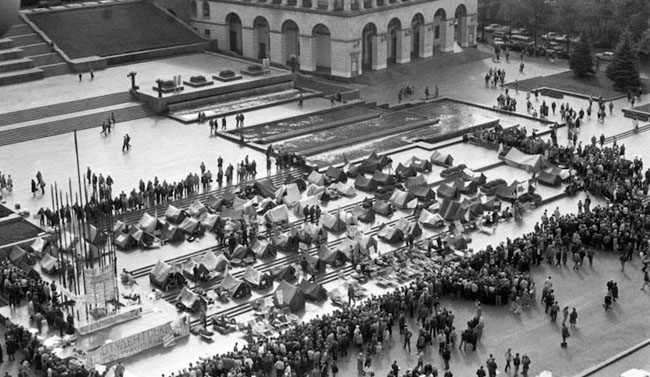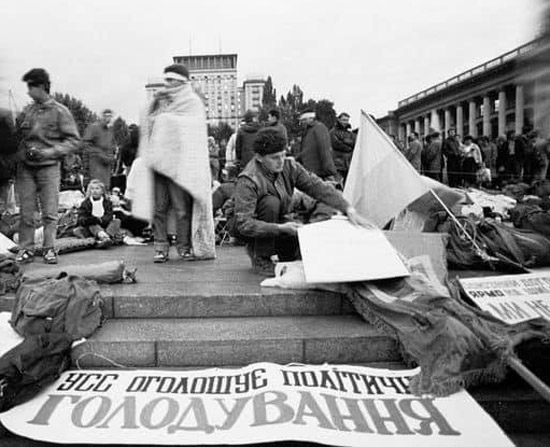Revolution on Granite
Revolution on Granite (революція на граніті; revoliutsiia na hraniti). A student demonstration and hunger strike in central Kyiv in October 1990, which resulted in the resignation of the prime minister of the Ukrainian Soviet Socialist Republic, Vitalii Masol, and set a pattern for future peaceful yet highly effective political protests in Ukraine. While its demands on the government were not fully or immediately met, it came to be regarded as the initial wave in the country’s national liberation and democratization.
The context for this first-ever successful peaceful protest was provided by Mikhail Gorbachev’s policy of perestroika that began in 1987, and the fall of communist rule in Eastern Europe in 1989. This created economic and political uncertainty, opened the door to questioning the competence and legitimacy of the Communist Party of Ukraine’s (CPU) leadership, and emboldened people to demonstrate in public in favor of reforms and their rights. There was a wave of strikes in 1989–90 by miners in the Donets Basin, who demanded improvements in wages, working conditions, and standards of living. Even Gorbachev in Moscow found these strikes alarming. In the Ukrainian SSR, in September 1990, at the call of the Popular Movement of Ukraine (Rukh), some 100,000 people turned out in Kyiv to protest against signing on to Gorbachev’s proposed Union Treaty. For its part, the CPU leadership, feeling vulnerable, began to soften its harsh rule and to distance itself from subordination to Moscow. In July 1990, the Supreme Soviet of the Ukrainian SSR passed the Declaration on the State Sovereignty of Ukraine, responding to the public mood at the time.
On 2 October 1990, a contingent of some 100 students from Kyiv, Lviv, and Kharkiv set up a tent city or encampment in October Revolution Square (later Independence Square) and began a hunger strike. They vowed to continue their strike until their demands were met by the authorities. Specifically, the strikers wanted: the chairman of the Council of Ministers of the Ukranian SSR, Vitalii Masol, to resign; multi-party elections to be held; the proposed Union Treaty to be rejected; Ukrainian armed forces personnel to serve only in Ukraine, not elsewhere in the USSR; and the CPU’s property to be nationalized. The number of direct participants rose to about 300 by the end, but it attracted many supporters and sympathizers so that at its peak the square contained around 2,000 people. The demonstration took its name from the granite slabs on which the tents were pitched.
The militia did not forcibly disperse the demonstration as would have been expected. A second camp was put up in front of the building of the Supreme Soviet of the Ukrainian SSR where a number of people’s deputies were sympathetic to the students, one of them being their organizer. The chairman of the Supreme Soviet, Leonid Kravchuk, met the demonstrators and helped to have their demands heard by the assembly. The Supreme Soviet established a commission to examine their demands, agreed with them, and most were eventually realized. The protest ended on 17 October with the resignation of Vitalii Masol. The Supreme Soviet was moved to act under the threat of a general strike in support of the students’ demands.
The practice of occupying the Maidan Nezalezhnosti (Independence Square) for the purposes of peaceful political protest—as opposed to merely marching in the streets, a passing show—became an established practice for major demonstrations thereafter. Turning the Maidan into a self-sufficient community or carnival thereafter on such occasions was an effective way of publicizing and sustaining protest. Like those that followed—the Orange Revolution of 2004 and the Euromaidan Revolution of 2013–14—the Revolution on Granite was a leaderless revolution, more a manifestation of people power. Several participants later became leaders of political parties, notably Oleh Tiahnybok of Svoboda (Freedom) and Sviatoslav Vakarchuk of Holos (Voice). Even though it was not a revolution in the full sense, the Revolution on Granite unwittingly served as a precedent for making incremental progress towards democracy by carrying out its particular manner of contentious politics in Ukraine.
BIBLIOGRAPHY
O’Connor, C.; Tereshchuk, H. ‘The Revolution on Granite: Ukraine’s “First Maidan”,’ RadioFreeEurope/RadioLiberty, 15 October 2020
Nikolayenko, O. ‘Mapping Support for a Revolution: Evidence from Ukraine,’ International Journal of Sociology, 51, no. 3 (2021)
Bohdan Harasymiw
[This article was written in 2023.]

.jpg)


